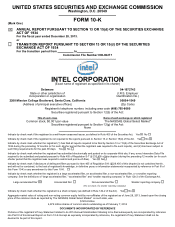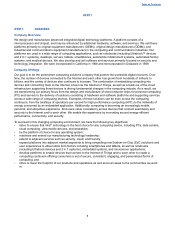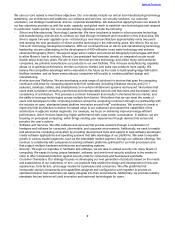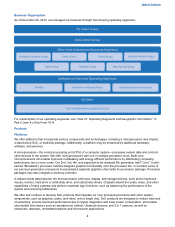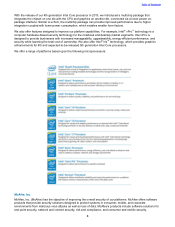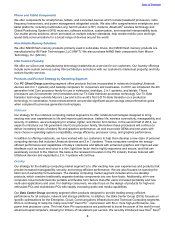Intel 2013 Annual Report Download - page 6
Download and view the complete annual report
Please find page 6 of the 2013 Intel annual report below. You can navigate through the pages in the report by either clicking on the pages listed below, or by using the keyword search tool below to find specific information within the annual report.
1
PART I
ITEM 1. BUSINESS
Company Overview
We design and manufacture advanced integrated digital technology platforms. A platform consists of a
microprocessor and chipset, and may be enhanced by additional hardware, software, and services. We sell these
platforms primarily to original equipment manufacturers (OEMs), original design manufacturers (ODMs), and
industrial and communications equipment manufacturers in the computing and communications industries. Our
platforms are used in a wide range of computing applications, such as notebooks (including Ultrabook™ devices
and 2 in 1 systems), desktops, servers, tablets, smartphones, automobile infotainment systems, automated factory
systems, and medical devices. We also develop and sell software and services primarily focused on security and
technology integration. We were incorporated in California in 1968 and reincorporated in Delaware in 1989.
Company Strategy
Our goal is to be the preeminent computing solutions company that powers the worldwide digital economy. Over
time, the number of devices connected to the Internet and each other has grown from hundreds of millions to
billions, and the variety of devices also continues to increase. The combination of embedding computing into
devices and connecting them to the Internet, known as the Internet of Things, as well as a build-out of the cloud
infrastructure supporting these devices is driving fundamental changes in the computing industry. As a result, we
are transforming our primary focus from the design and manufacture of semiconductor chips for personal computing
(PC) and servers to the delivery of solutions consisting of hardware and software platforms and supporting services
across a wide range of computing devices. Examples of these solutions can be seen across the computing
continuum, from the teraflops of operations per second for high performance computing (HPC) to the milliwatts of
energy consumed by an embedded application. Additionally, computing is becoming an increasingly mobile,
personal, and ubiquitous experience. End users value consistency across devices that connect seamlessly and
securely to the Internet and to each other. We enable this experience by innovating around energy-efficient
performance, connectivity, and security.
To succeed in this changing computing environment, we have the following key objectives:
• strive to ensure that Intel® technology is the best choice for any computing device, including PCs, data centers,
cloud computing, ultra-mobile devices, and wearables;
• be the platform of choice for any operating system;
• maximize and extend our manufacturing technology leadership;
• extend to adjacent services such as security, cloud, and foundry;
• expand platforms into adjacent market segments to bring compelling new System-on-Chip (SoC) solutions and
user experiences to ultra-mobile form factors including smartphones and tablets, as well as notebooks
(including Ultrabook devices and 2 in 1 systems), embedded systems, and microserver applications;
• develop platforms to enable devices that connect to the Internet of Things and to each other to create a
computing continuum offering consumers a set of secure, consistent, engaging, and personalized forms of
computing; and
• strive to lower the footprint of our products and operations as well as be an asset to the communities we work
in.
Table of Contents




